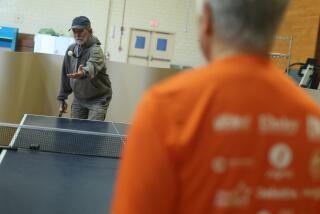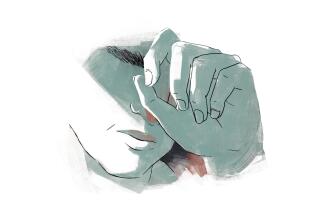Society Must Help Seniors Stay Productive, Experts Say : Often Hidden, Suicide Is on Rise Among Elderly
- Share via
RICHMOND, Va. — The day after his wife died, an 83-year-old man sat in his dining room, surrounded by relatives, crying. “Why did she have to leave me?” he moaned. Then he went into the bedroom and killed himself.
A former hard-driving insurance executive in his 60s, unable to adjust to the slower pace of retirement and depressed because of the loss of identity he derived from his work, took a job pumping gas six months after settling in a retirement community. Three months later, he committed suicide.
An 82-year-old man with the debilitating and ultimately fatal amyotrophic lateral sclerosis--Lou Gehrig’s disease--was becoming increasingly helpless. Not wishing to burden his wife, he slashed his wrists and bled to death.
The cases are typical of what experts say is a growing phenomenon, but one that can go unrecognized because some deaths aren’t obviously suicide.
“I’ve known people who would just sit in their apartments and eat nothing but 2 or 3 pieces of toast a day. Eventually they die from malnutrition,” said Dr. Marv Miller, a San Diego gerontologist who wrote in 1979 that the elderly “are deadly serious about killing themselves.”
Elderly Not Respected
As the older population grows in a youth-oriented society, the problem is worsening, Miller said. “In some societies older people are venerated and respected, but not in this one.
“Once people are out of the work force and no longer contributing to the productivity of society in an economic sense, society no longer has any use for them. This is a shame because after the Depression, this country was built back by the people who are now the elderly.”
In 1986, the most recent figures available, the nation’s suicide rate was 12.8 per 100,000 people. For those 65 and over, the rate was 21.6 per 100,000; within that group, the breakdown was 19.7 for ages 65-74; 25.2 for those 75-84; and 20.8 for those 85 and older. Ten years previously, those rates were 17.8, 20.8 and 17.9, respectively.
The National Center for Health Statistics, which compiles data from death certificates, reported 2,146 suicides among people 19 and younger in 1986, and 6,275 in the 65-and-over group. Miller said the actual number could exceed 10,000 because of the under-reporting of elderly suicides.
“The figures are appalling,” said Dr. Robert N. Butler, author of the 1976 Pulitzer Prize-winning book “Why Survive? Being Old in America.”
Cuts in social programs and changing attitudes may be partly to blame for the 25% rise in late-life suicide since 1981, said Dr. Nancy J. Osgood, a Medical College of Virginia gerontologist. “In the last five or six years there has been a growing feeling that suicide is an acceptable solution to deal with life’s problems, especially if you’re old.”
Worse Among Men
The problem is worse among men, particularly white men. In 1986, the suicide rate among men ages 65-74 was 35.5, compared to 7.2 for women. In the 75-84 group, the rates were 54.8 and 7.5; for 85 and older, 61.6 and 4.7.
“Many men feel that when they are no longer working, they have no value. They have merged their work with their identity, which precipitates an identity crisis upon retirement. They are traumatized by so much free time,” said Miller, author of “Suicide After Sixty. The Final Alternative.”
Today’s elderly women, on the other hand, “were wife and mother, and maintain their same roles throughout life,” he said. They also can ask for help without it being interpreted as a sign of weakness.
“Men can’t do that,” he said. “Men can’t even cry.”
In addition to the loss of self-worth brought by retirement, other major reasons for suicide among the elderly are loss of a loved one, physical illness and, to a lesser extent, a motivation to defy or control death, which Miller said is becoming more common for people who are terminally ill.
Covert Suicide
While shooting is the primary method among all suicides, the elderly sometimes use covert techniques like starvation, refusal to take medicine and over-dosing on prescribed drugs. Such covert suicide, combined with the stigma of taking one’s life, leads to under-reporting, Miller said.
“Someday, someone very close to a President will commit suicide, and then there will be a hue and cry raised across the country. We need the President to enunciate a clear policy to lower the number of suicides by a certain time.”
Reporting would be improved if doctors were taught to recognize the signs of suicide, and outreach programs should be set up to identify and treat potentially suicidal older people, experts say.
Warning Signals
The warning signs include behavior like stockpiling medicine, changing wills and buying a gun. Other indications are extreme mood and behavior swings, expressed feelings of hopelessness and worthlessness and major changes in weight, eating and sleeping patterns.
Only California, Delaware, New Hampshire, Pennsylvania and Rhode Island have state-operated suicide prevention and intervention programs aimed at older people, according to an October, 1988, survey for the American Assn. of Retired Persons. Virginia is planning a statewide education effort.
Nevada has the nation’s highest rate of geriatric suicide at 32.2 per 100,000 people, followed by Arizona, California, Colorado, Vermont, New Mexico, Idaho, Oregon, Virginia and Florida, said Dr. John L. McIntosh, a psychologist at Indiana University who specializes in the elderly. Massachusetts, with a rate of 9.9 per 100,000 people, was the nation’s lowest.
“No one knows for sure” why rates are high in some states, said McIntosh, who wrote “Suicide and the Elderly” with Osgood in 1986. The reason could lie in geographic isolation and easy availability of firearms in rural areas.
National Program Needed
The suicide rate could be reduced by a national program that encouraged the elderly to remain productive, said Butler, director of geriatrics at the Mount Sinai School of Medicine in New York. He suggested creating a National Senior Service Corps to take advantage of the vast, untapped talent pool.
There are any number of such programs for the young, but none for older people, he said. “Once again as a society we’re missing the boat. We should create opportunities for the elderly to contribute to society. It’s a shame not to make use of such talent.”
Miller suggested putting day-care centers in nursing homes “where elderly people, who have an affinity for children, would care for them and even be paid for it.” Corporate America also could play a significant role by providing pre- and post-retirement counseling and letting workers put in fewer hours three or four years before they retire, cushioning the shock of leaving.
“Anyone without sensitivity to the problem is really short-sighted,” he said. “We’re all going to be elderly one day.”
More to Read
Sign up for Essential California
The most important California stories and recommendations in your inbox every morning.
You may occasionally receive promotional content from the Los Angeles Times.













